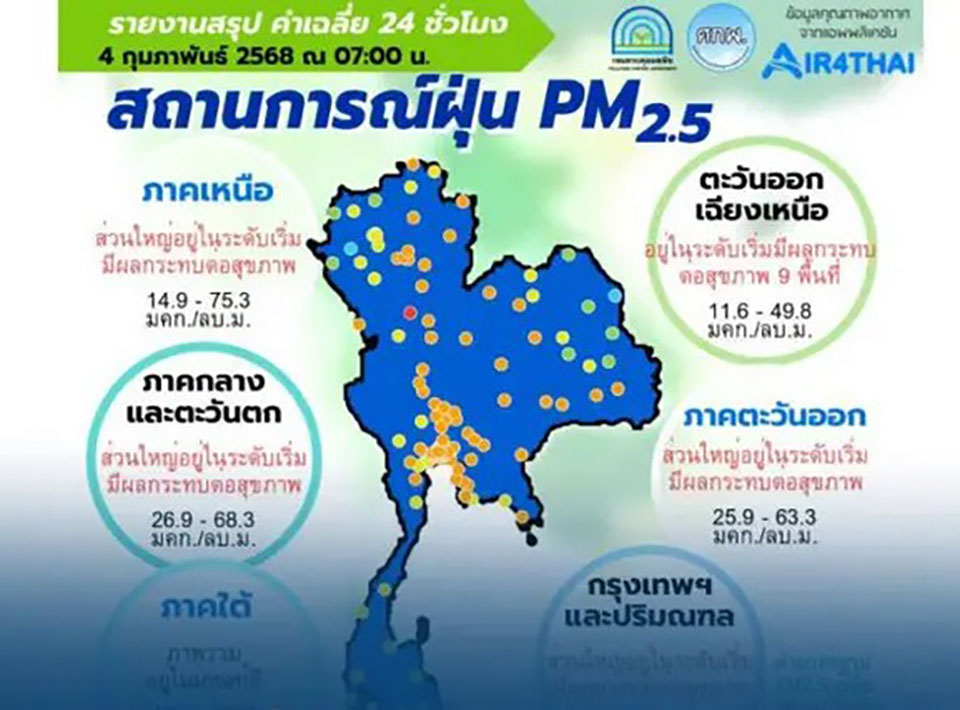
BANGKOK, Thailand – The Pollution Control Department has issued a warning about dangerously high PM2.5 pollution levels in 43 provinces across Thailand. Satellite images have detected multiple hotspots, particularly in forested areas, while stagnant weather conditions and unpredictable winds are exacerbating air pollution. Authorities have urged the public to remain vigilant against fine particulate pollution until February 9.
According to the Air Pollution Solution and Communication Center (APSC) under the Pollution Control Department, air quality monitoring as of 7:00 AM on February 4 revealed PM2.5 levels exceeding safety standards in 13 provinces, including Pathum Thani, Bangkok, Nonthaburi, Nakhon Pathom, Samut Sakhon, Samut Prakan, Chiang Rai, Nan, Phayao, Lampang, Phrae, Uttaradit, and Sukhothai.
The affected regions extend to Phitsanulok, Tak, Phichit, Phetchabun, Nakhon Sawan, Uthai Thani, Chai Nat, Sing Buri, Lop Buri, Saraburi, Ang Thong, Ayutthaya, Ratchaburi, Phetchaburi, Nakhon Nayok, Prachin Buri, Sa Kaeo, Chachoengsao, Chonburi, Rayong, Trat, Loei, Nong Bua Lamphu, Khon Kaen, Chaiyaphum, Ubon Ratchathani, Si Sa Ket, Nakhon Ratchasima, Buri Ram, and Surin.
Regional Air Quality Overview:
Northern Region: PM2.5 levels exceeded safety limits in most areas, ranging from 14.9 to 75.3 µg/m³.
Northeastern Region: Nine areas recorded PM2.5 levels above the standard, ranging from 11.6 to 49.8 µg/m³.
Central and Western Regions: Most areas exceeded the safety limit, with levels between 26.9 and 68.3 µg/m³.
Eastern Region: High pollution levels were recorded, ranging from 25.9 to 63.3 µg/m³.
Southern Region: Air quality remained within safe limits, with PM2.5 levels between 16.4 and 32.2 µg/m³.
Bangkok and Metropolitan Region: Pollution levels were high in most areas, ranging from 29.4 to 61.2 µg/m³.
While PM2.5 levels are expected to briefly subside between February 4-5, pollution is predicted to intensify again, particularly in Bangkok and surrounding provinces, the Eastern Region, parts of the Northeast, and the lower Northern Region. The worsening air quality is attributed to stagnant air, low atmospheric dispersion, and fluctuating wind patterns, with occasional southern and southeasterly winds.
Additionally, satellite data from GISTDA shows an increase in fire hotspots, mainly in forests and agricultural areas, particularly in the Northern, Central, and Western regions, as well as parts of the Northeast.
The APSC has urged relevant authorities to tighten regulations on pollution sources to mitigate the severity of the PM2.5 crisis and protect public health, especially vulnerable groups such as the elderly, children, pregnant women, and individuals with respiratory conditions. Citizens are advised to limit outdoor activities, wear protective masks, follow health ministry guidelines, and consider remote work (WFH) arrangements where possible. The public is also encouraged to report illegal burning activities, as many provinces have already imposed bans on open-air burning to control fire outbreaks.
For real-time air quality updates, citizens can visit Air4Thai.pcd.go.th or use the Air4Thai mobile application. (TNA)










